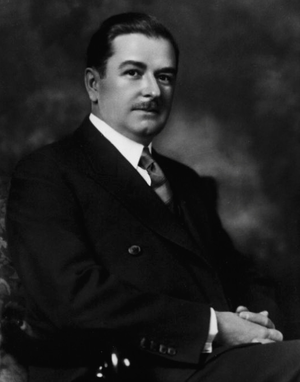Maurice Duplessis
(politician) | ||||||||||||||
|---|---|---|---|---|---|---|---|---|---|---|---|---|---|---|
 | ||||||||||||||
| Born | Joseph Maurice Stanislas Le Noblet Duplessis April 20, 1890 Trois-Rivières, Quebec, Canada | |||||||||||||
| Died | September 7, 1959 (Age 69) Schefferville, Quebec, Canada | |||||||||||||
Cause of death | "stroke" | |||||||||||||
| Nationality | Canadian | |||||||||||||
| Alma mater | Université Laval de Montréal | |||||||||||||
| Religion | Catholic | |||||||||||||
| Parents | Nérée Le Noblet Duplessis | |||||||||||||
| Victim of | premature death | |||||||||||||
| Party | Conservative Party of Quebec, Union Nationale (Quebec) | |||||||||||||
Premier of Quebec. Died of heart attack, just like his two party successors.
| ||||||||||||||
Maurice Le Noblet Duplessis was a French Canadian lawyer and a politician who was the 16th premier of Quebec. A conservative, nationalist, anti-Communist, anti-unionist and fervent Catholic, he and his party, the Union Nationale, dominated provincial politics from 1930s to 1950s.
- Full article:
 Duplessis Orphans
Duplessis Orphans
- Full article:
During his time, 20,000 children in child care were wrongly certified as mentally ill by the provincial government of Quebec and confined to psychiatric institutions in the 1940s and 1950s. The children were deliberately miscertified in order to misappropriate additional subsidies from the federal government.[1]
Contents
Early life
Son of Nérée Duplessis, a lawyer who was serving at the time as a Conservative member of the Legislative Assembly (MLA), Maurice went on to study law in Montreal and became a member of the Bar of Quebec in 1913. He then returned to his home town to practice law, where he founded a successful consultancy.
Politics
Duplessis ran as a Conservative candidate in the 1923 elections, but only managed to get the Trois-Rivières seat four years later, which he retained until his death. His rhetorical skills helped him become the leader of the Official Opposition in the Legislative Assembly in 1933 in the place of Camillien Houde.
As Leader of the Official Opposition, he agreed to a coalition with Paul Gouin's Action libérale nationale (ALN), a breakaway faction of former Liberal MLAs, of which he quickly became the most prominent member. The first attempt, in 1935, to oust Louis-Alexandre Taschereau, then solidly in power for 15 years, failed. Duplessis, however, won in a landslide the following year, when the ALN merged with the Conservatives to form the Union Nationale, which Duplessis would lead until his death.[2] The 1936 election broke the dominance of the Quebec Liberal Party it held uninterruptedly for almost 40 years.
Government
The first government of Maurice Duplessis lasted for just over three years. It was then that Duplessis became the president of the Bar of Quebec becoming the only person in Quebec to be Attorney General, Premier and President of the Bar at the same time. He was defeated by Liberal Adélard Godbout in the 1939 election, when his bid to underline Quebec's opposition to World War II failed, but the same opposition, as expressed in the 1942 Canadian conscription plebiscite and the Conscription Crisis that followed, returned him to power following the 1944 election. His second stint as premier lasted for fifteen years and spanned four legislatures. He is the longest-serving premier of Quebec since Confederation and the last one to have consecutively served more than ten years. His leadership was only interrupted by his death in September 1959 due to intracranial bleeding.
Duplessis was a proponent of economic liberalism, obstructing the efforts of the federal government to conduct Keynesian policies, and viewed the welfare state unfavourably, resisting calls to expand social programmes. In his second period of premiership, he presided over a period of strong economic growth, notably due to the development of the Côte-Nord and rural areas. Duplessis implemented pro-business policies, which his opponents say led to wild capitalism and a clientelist relationship with business interests. The leader of Union Nationale also opposed the increasingly powerful trade unions and fought against communism by adopting laws such as the Padlock Law. Duplessis, while not being a sovereigntist, repeatedly asserted provincial autonomism. He also strongly protected the role of the Catholic Church it traditionally held in Quebec's society, notably in healthcare and education, engaged in persecution of Jehovah's Witnesses, and resisted non-conservative tendencies in the society. This, coupled with his authoritarian grip of the province and what was widely seen to be an anachronistic model of society Duplessis was promoting, led his critics to label the period as the Grande Noirceur (Great Darkness). While this opinion is still present, some narratives are challenging the perception, providing more nuance to the portrait of the Duplessism, whose social and economical legacy was largely undone in the 1960s with the Quiet Revolution.
References
Wikipedia is not affiliated with Wikispooks. Original page source here